M
I
C
R
O
S
T
O
R
Y
O
F
A
R
T
........................................................

NOW COMPLETED:

........................................................
MICROSTORY OF ART
ONLINE JOURNAL FOR ART, CONNOISSEURSHIP
AND CULTURAL JOURNALISM
........................................................
INDEX | PINBOARD | MICROSTORIES |
FEATURES | SPECIAL EDITIONS |
HISTORY AND THEORY OF ATTRIBUTION |
ETHNOGRAPHY OF CONNOISSEURSHIP |
SEARCH

........................................................



 >MICROSTORIES
>MICROSTORIES
- Richard Serra
- Martin Scorsese
- Claude Simon
- Sunshine
- Werner Herzog
- The Creation
- Marcel Duchamp
- Nino Rota
- Wölfflin and Woolf
- Hansjörg Schneider
- Kraftort Arkadien
- Visual Biography
- Schlaraffenleben
- Die Geisteswissenschaften
- The Voyeur
- Buzzword Sustainability
- Paul Verlaine
- Tao Yuanming
- New Beginning
- Seneca
- Still Lifes
- Charles Baudelaire
- Frédéric Chopin
- The Art History of Sustainability
- Wang Wei
- Solarpunk
- Historians of Light
- Lepanto
- Renaturalization
- Plates
- Snow in Provence
- Learning to See
- Picasso Dictionaries
- Peach Blossom Spring
- Picasso Tourism
- Tipping Points
- Sviatoslav Richter
- Weather Reports
- Treasure Hunt
- Another Snowscape in Picasso
- Picasso in 2023
- Dragon Veins
- The Gloomy Day
- The Art of the Pentimento
- Reforestation
- The Status of Painting
- Emergency Supply
- Punctuality
- Watching Traffic
- Zhong Kui
- How Painting Survived the 1990s
- Confirmation Bias
- Sustainability and Luxury
- Garage Bands
- Picasso and Artificial Intelligence
- Eyes of Tomorrow
- Picasso in 2023 2
- Gluing Oneself to Something
- Suburbia
- Bamboo
- Sustainability and Carpe Diem 1
- Interviews with Bruegel
- Sustainability and Carpe Diem 2
- Coffee & Sugar
- Bamboo 2
- Picasso in 2023 3
- Sustainability and Carpe Diem 3
- Cherry Orchard
- Old Magazines
- Chance
- Nick Drake
- Harlequin
- The Smartphone & the Art Book
- Atlas Syndrome
- The Kitchen
- Atlas Syndrome 2
- Consideration
- Tori Amos
- School
- Orchard Auctioning Day
- The Hundred Years’ War
- Sócrates
- Chameleon
- Nefertiti Bust
- Picasso as a Computer
- Sunflowers
- Philemon & Baucis
- Ode to the Radio
- Childhood
- Wimmelbild
- Restitution
- Nick Drake 2
- Wishful Thinking
- Sundays
- The Independent Scholar
- September
- The Fisherman by Pirosmani
- Microadventure
- Sociology
- Salvator Mundi
- Chillon
- Appassionata
- Amber
- Homer
- Berlin
- Planet Walk
- Improvisation
- Seeing Picasso
- These Nice Kids
- Robber
- The One
- The Sea Turtle
- Zoo
- Through the Hush
- Wunderkammer
- I Do Not Seek, I Find
- Shopping Mall
- Food Hamper
- The Secretary
- This Gate
- Nor Rainy Day
- House on a Hill
- Beautiful Island
- Second-hand Bookstore
- Flat
- Slap in the Face
- Serra, Wenkenpark
- Apologies
- The Bells
- Nordmann Fir
- Picasso Wanting To Be Poor
- Picasso, Pirosmani
- A Brief History of Sculpture
- 24 Sunsets
- Rusty Phoenix
- Glove
- Wintry Stanza
- A Song
- Like A Beatle
- Catching An Orange
- Solar Bees
- Permaculture

 >FEATURES
>FEATURES
- Van Gogh On Connoisseurship
- Two Museum’s Men
- Ende Pintrix and the City in Flames
- Titian, Leonardo and the Blue Hour
- The Man with the Golden Helmet: a documentation
- Un Jury d’admission à l’expertise
- Learning to See in Hitler’s Munich
- Leonardo da Vinci and Switzerland
- The Blue Hour Continued
- The Blue Hour in Louis Malle
- Kafka in the Blue Hour
- Blue Matisse
- Blue Hours of Hamburg and LA
- A Brief History of the Cranberry
- The Other Liberale in the House
- The Blue Hour in Raphael
- Who Did Invent the Blue Hour?
- Monet on Sustainability
- Velázquez and Sustainability
- The Blue Hour in Guillaume Apollinaire
- Van Gogh on Sustainability
- The Blue Hour in Marcel Proust
- Picasso and Sustainability
- The Contemporary Blue Hour
- The Blue Hour in 1492
- The Blue Hour in Hopper and Rothko
- Hopper and Sustainability
- The Blue Hour in Ecotopia
- The Hour Blue in Joan Mitchell
- Explaining the Twilight
- The Twilight of Thaw
- The Blue Hour in Pierre Bonnard
- Explaining the Twilight 2
- Picasso on Stalin
- Rubens on Sustainability
- The Salvator Mundi in Bruegel and Rubens
- The Blue Hour in Leonardo da Vinci and Poussin
- The Blue Hour in Rimbaud
- Faking the Dawn
- Frost and Thaw in Ilya Ehrenburg
- Picasso, Stalin, Beria
- Picasso, Solzhenitsyn and the Gulag
- Shostakovich on Picasso
- Hélène Parmelin in 1956
- Historians of Picasso Blue
- Picasso Travelling to Moscow 1
- The Blue Hour in Caravaggio
- Picasso Travelling to Moscow 2
- Picasso, the Knife Game and the Unsettling in Art
- Some Notes on Leonardo da Vinci and Slavery
- Picasso Moving to the Swiss Goldcoast
- The Blue Hour in Camus
- The Blue Hour in Symbolism and Surrealism
- Caspar David Friedrich in His Element
- Exhibiting the Northern Light
- Caspar David Friedrich in His Element 2
- Robert Schumann and the History of the Nocturne
- The Blue Hour in Robert Schumann
- Caspar David Friedrich and Sustainability
- The Twilight of Thaw 2
- Multicultural Twilight
- The Blue Hour in Anton Chekhov
- The Blue Hour in Medieval Art
- Twilight Photography
- The Blue Hour in Bob Dylan
- Iconography of Optimism

 >SPECIAL EDITIONS
>SPECIAL EDITIONS
- Visions of Cosmopolis
- Mona Lisa Landscapes
- Turner and Ruskin at Rheinfelden
- Painters On TV & On TV
- Spazzacamini in Art
- A Last Glance at Le Jardin de Daubigny
- The Experimental Cicerone
- A Dictionary of Imaginary Art Historical Works
- Iconography of Blogging
- Begegnung auf dem Münsterplatz
- Cecom
- Das Projekt Visual Apprenticeship
- Those Who See More
- A Fox on Seeing with the Heart
- Sammlung Werner Weisbach
- Daubigny Revisited
- Some Salvator Mundi Microstories
- Some Salvator Mundi Afterthougths
- Some Salvator Mundi Variations
- Some Salvator Mundi Revisions
- A Salvator Mundi Questionnaire
- A Salvator Mundi Puzzle
- Unknown Melzi
- Francis I and the Crown of Charlemagne
- From Amboise to Fontainebleau
- Drones Above Chambord
- Looking Back At Conques
- Flaubert At Fontainebleau
- Images of Imperial Ideology
- The Chronicles of Santa Maria delle Grazie
- Seeing Right Through Someone
- Melzi the Secretary
- Eying Glass
- A Foil to the Mona Lisa
- A Renaissance of the Cartoon
- Sketching a Family Tree
- Venetian Variations
- A Brief History of Digital Restoring
- A Consortium of Painters
- Leonardeschi and Landscape
- A Christ in Profile
- Learning to See in Spanish Milan
- A History of Gestures
- Leonardo and Josquin
- A Renaissance of the Hybrid
- Suida and Heydenreich
- The Watershed
- Three Veils
- From Beginning to End
- Connoisseurship of AI
- Twilight and Enlightenment
- The Blue Hour in Chinese Painting
- Dusk and Dawn at La Californie
- Iconography of Sustainability
- The Blue Hour in Goethe and Stendhal
- The Sky in Verlaine
- The Blue Hour in Paul Klee
- Iconography of Sustainability 2
- The Blue Hour in Charles Baudelaire
- From Bruegel to Solarpunk
- Some Salvator Mundi Documentaries
- Some More Salvator Mundi Monkey Business
- The Windsor Sleeve
- Brigitte Bardot’s Encounter with Picasso
- Art Historians and Historians
- A Salvator Mundi Chronicle
- The Salvator Mundi and the French Revolution
- The Fontainebleau Group
- The Encounter of Harry Truman with Pablo Picasso
- The Fontainebleau Group Continued
- The Windsor Sleeve Continued
- The Salvator Mundi in Early Netherlandish Painting 1
- Some Salvator Mundi Resources
- A New Salvator Mundi Questionnaire
- The Woman in Picasso
- The Yarborough Group
- Melzi, Figino and the Mona Lisa
- The Yarborough Group Continued
- A Salvator Mundi Global History
- The Salvator Mundi in Medieval Art
- The Salvator Mundi in Medieval Art 2
- The Salvator Mundi in Early Netherlandish Painting 2


 >HISTORY AND THEORY OF ATTRIBUTION
>HISTORY AND THEORY OF ATTRIBUTION
- The Mysterious »Donna Laura Minghetti-Leonardo«
- Assorted Demons of Connoisseurship
- Panofsky Meets Morelli
- Discovering the Eye of Sherlock Holmes
- Handling the Left-handed Hatchings Argument
- Visual History of Connoisseurship
- Alexander Perrig
- Connoisseurship in 2666
- What Postmodernity Has Done to Connoisseurship
- Dividing Four Fab Hands
- A Leonardesque Ambassador
- Test Cases in Connoisseurship
- A Raphael Expertise
- How to Tell Titian from Giorgione
- Louise Richter
- The Unique Property in the History of Connoisseurship
- An Expertise by Berenson
- The Book of Expertises
- An Album of Expertises
- An Expertise by Friedländer
- A Salvator Mundi Provenance
- How to Tell Leonardo from Luini
- An Expertise by Crowe and Cavalcaselle
- An Expertise by Bayersdorfer
- An Expertise by Hermann Voss
- An Expertise by Hofstede de Groot
- Leonardeschi Gold Rush
- An Unknown »Vermeer«
- An Expertise by Roberto Longhi
- An Expertise by Federico Zeri
- A Salvator Mundi Geography
- A Salvator Mundi Atlas
- The Bias of Superficiality
- 32 Ways of Looking at a Puzzle
- James Cahill versus Zhang Daqian
- Five Fallacies in Attribution
- On Why Art History Cannot Be Outsourced to Art Dealers
- On Why Artificial Intelligence Has No Place in Connoisseurship
- Salvator Mundi Scholarship in 2016
- Leonardo da Vinci at the Courts
- The Story of the Lost Axe
- The Last Bruegel
- A Titian Questionnaire
- On Where and Why the Salvator Mundi Authentication Did Fail
- The Problem of Deattribution

 >ETHNOGRAPHY OF CONNOISSEURSHIP
>ETHNOGRAPHY OF CONNOISSEURSHIP
MICROSTORY OF ART
ONLINE JOURNAL FOR ART, CONNOISSEURSHIP
AND CULTURAL JOURNALISM
........................................................

***
ARCHIVE AND FURTHER PROJECTS

1) PRINT


***
2) E-PRODUCTIONS


........................................................

........................................................

........................................................
FORTHCOMING:


***
3) VARIA

........................................................

........................................................

........................................................

........................................................

........................................................
***
THE GIOVANNI MORELLI MONOGRAPH

- The Giovanni Morelli Monograph
........................................................
MICROSTORY OF ART
ONLINE JOURNAL FOR ART, CONNOISSEURSHIP AND CULTURAL JOURNALISM
HOME
MICROSTORY OF ART ONLINE JOURNAL FOR ART, CONNOISSEURSHIP AND CULTURAL JOURNALISM The Watershed  |
See also the episodes 1 to 25 of our New Salvator Mundi History:
Francis I and the Crown of Charlemagne
The Chronicles of Santa Maria delle Grazie
A Brief History of Digital Restoring
Learning to See in Spanish Milan
And:
The Watershed
(14.-15.10.2021) The Salvator Mundi drama can be described as a saga, but it could also be described as a crisis, a crisis of
discernment, and as a crisis in the capacity of a whole scholarly discipline to solve a problem. I have been very
critical in several, and also in recent episodes, and I am also going to be critical in this 26. episode of our New Salvator
Mundi History. But this is not about single persons. Actually I am even willing to defend the scholars who have had the
courage to take responsibility, even if they have fallen into error. Every scholar has strengths, as goes without saying,
and also weaknesses. What is less excusable, however, is what I am calling the lame-duckness, yes, lame-duckness of a
whole scholarly discipline. Because the scholars who have not taken any responsibility, simply have had little to offer
in the last ten years, concerning the solving of a problem. The more substantial attempts have come from outside the
academe. And this crisis in discernment, but also in scholarly method and practice, has reasons. And in the following I am
going to discuss these reasons.
Below we see pictures recalling various aspects of 1960s history (picture: CatJar). But ›history cannot be seen, just as
one cannot see grass growing‹, Boris Pasternak can be quoted. I don’t know whether this applies to all of history, but
the following is about the period c. 1960, as well as it is about things that are hard to detect while they are happening.
(picture above and in title: Henry Herbert La Thangue, The Connoisseur, 1887)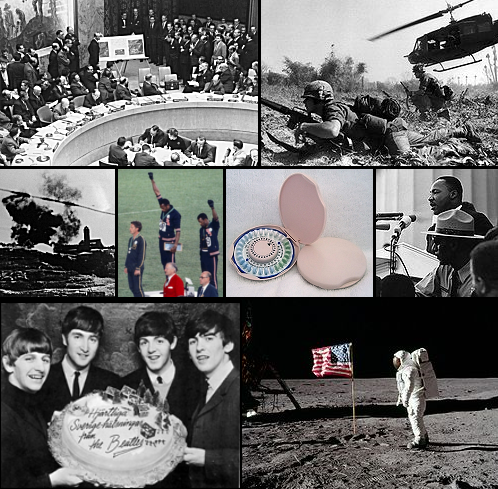
One) Something Untimely
In around 1960 conoisseurship was perceived as something untimely, out of fashion, obsolete. Bernard Berenson had passed
away in 1959, and this date, in our context, is of symbolic relevance.
The discipline of art history, especially during the 1960s, embarked to new horizons: social history, psychoanalysis etc., as
well as, somewhat later, deconstruction and gender studies and so forth. If scholars continued to look, they looked at new things.
Discernment re-focussed, and connoisseurship, the establishing of informations as to authorship of works of art, was
considered as something that, on the one hand, already had been done, largely at least (by people like Berenson), and as
something that academic art historians, as far as they had cared about it before, could leave to other people, who
continued to cherish these old-fashioned practices (or pretended to do so), especially in the context of the (Old
Masters) art market. Connoisseurship had also an odour: it smelled of class, of leisure class, snobby esthetes of the
kind Berenson had – although not belonging, due to his humble beginnings , to that class himself – assembled around him,
and – charlatanism. Could there be something more untimely in around 1960?
Ironically one man was capable to transfer several aspects of what connoisseurship and its habitus had been to Modernism,
to Modern art. This man was Douglas Cooper, mentor of John Richardson (with whom he lived in the South of France, and
who would, later, define a shape of his own life as the biographer of Pablo Picasso). In our context, there might also
be another reason to mention Cooper, collector, curator, author, art historian, because Cooper had also been in the orbit
of Berenson. And when, after the War, Berenson tried to help Ludwig Heinrich Heydenreich to build a new existence,
because Heydenreich had helped him, Berenson, during the War, he tried to do so by attempting to put him in contact with
Cooper (see Berenson-Clark-correspondence, edited by Robert Cumming; as well as the memoirs of Nicky Mariano).
In 1960, finally, a nicely done, if fragmentary, edition of the correspondence of Giovanni Morelli with his pupil Jean
Paul Richter had been published. A key source as to what it had been like to live in the culture of the connoisseurs,
with people like Morelli and Richter, who, almost day-by-day, had debated problems of authorship. But the continent of
connoisseurship, the culture of the connoisseurs, their social world, had sunk or was sinking, and with it the skills,
the practices, the frustrations as the victories, but above all (and in one word): the experiences that could be
gained within that world with its colourful inhabitants. The experiences as to looking, as well as the debates as to what
seeing and looking was capable of, and under what circumstances. A widespread misunderstanding has it that connoisseurship
had been only about looking, but this, decidely is wrong. Looking required thinking about how to look at all and at what
exactly, and this could be done (and debated) in many ways. Little of that, however, was ever transmitted directly. The
edition of the Morelli-Richter-correspondence could be seen also as a first step towards an archeology of connoisseurship
and its secrets. And from now on also a very simple, but, in its consequences, fatal error could be made. One could think
(erroneously) that by simply briefly looking into such sources, or by briefly looking into the books by Morelli,
connoisseurial skills could be acquired. At best such skills could, if still existing, be refreshed. By deciphering,
a papyrus on farming in Old Egypt one would hardly acquire the skills to be become, immediately, a Nile valley farmer.
In art history, however, the misunderstanding is widespread that art historians, because they have to do with visual
things, easily can become connoisseurs. Another misunderstanding, and one at the beginning of the history (or the
continuation of it) of the Sunday-connoisseur who, at the same time, or very often, happens to be an armchair professor.
Two) Loss of Practical Knowledge and Experience
The loss of practical knowledge shows in the publications on connoisseurship after 1960. The preface of the first
publication of the later notorious Rembrandt Research Project (started in 1968) is a document as to an almost complete loss of
theoretical and practical knowledge concerning Morellian connoisseurship, as it is a document of the optimism that
Technical Art History, now and in the future, would solve the problems of establishing authorship. At least, Rembrandt
connoisseurship was still seen as a problem (an unsolved one, as it probably still is, in 2021), but the spirit was one
that pushed the connoisseurs, if about to rise from their graves, back into them. Fifty years later, however, one had to
conclude that Technical Art History had not solved the problems satisfactorily, and that one had, at least partly, to
rehabilitate connoisseurship (or what one took it to be, because this is another question: what exactly had it been?).
The story of that project, in all its glory and misery, is telling as to the story we are telling here. And it was not
the only document as to how one saw things in around 1960 and in the 1960s, when many of the so-called leading scholars
still active today, were being socialized, acquiring their skills, absorbing, perhaps, also some of the prejudices as to
the world of the connoisseurs and what it had been like. Edgar Wind, who certainly had had little to do with that world,
transmitted, in his Reith lectures of 1959 (published somewhat later), his more or less misunderstood version of what
Morellian connoisseurship had been. And I am referring to the time at around 1960 as a watershed, no matter how broad
exactly that watershed was. But no one, at around 1960 was observing what was happening. Changes of that structural kind
as we are focussing at here, are not that easy to detect. While they are happening.
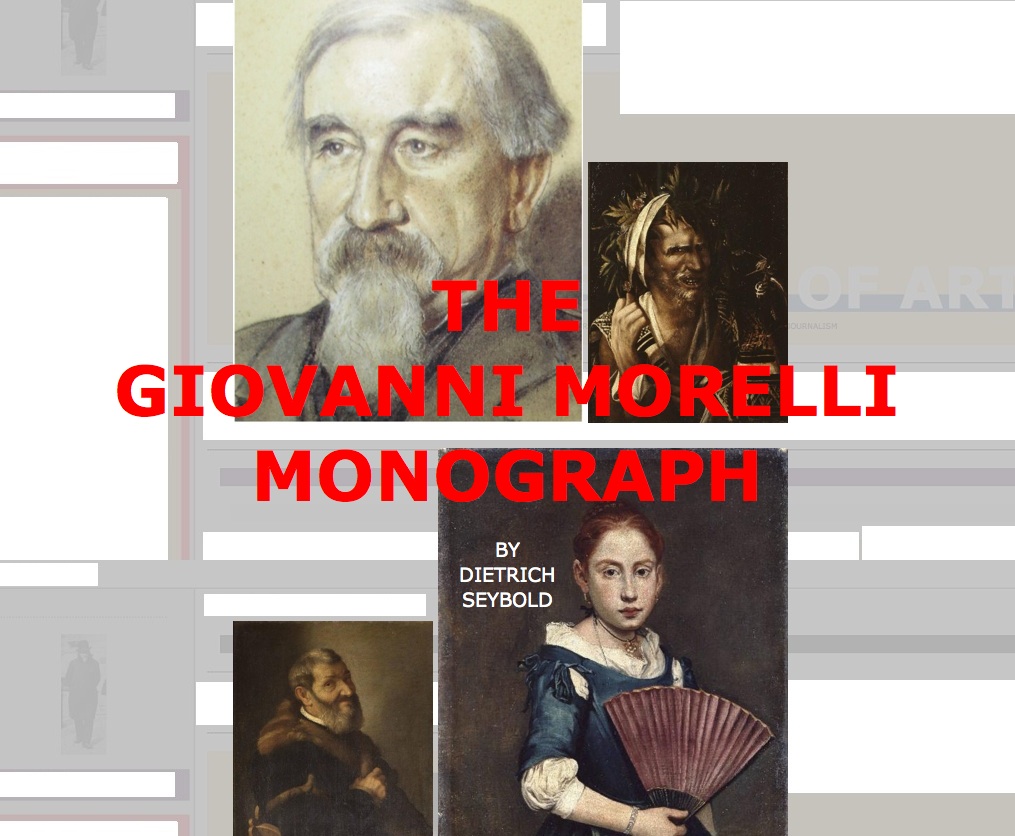

Three) Archeology of (Morellian) Connoisseurship
The problem of answering the question of what exactly connoisseurship had been is not only, but to a large extent
identical with the problem of answering what exactly Berensonian connoisseurship had been, and at what time. And this
problem is enhanced by the problem that Berensonian connoisseurship, in the beginning had been inspired by Morellian
connoisseurship, but, in the end, had turned into something completely different (I have spoken about that in the last
episode).
An archeology of connoisseurship has to dig deeper than to the layers of the years around 1960. It has to cover the full
career path, the trajectory, of Bernard Berenson, the one figure, that, like no other, has shaped the ideas of what
connoisseurship is and was, and could be. And these ideas, often, are wrong or, at best, misleading and incomplete. But
Berenson has influenced connoisseurship, and also Leonardo scholarship (since many scholars, still, uncritically, do
accept some of the Berensonian attributions, although they could know, that Berenson, with Leonardo and the Leonardeschi,
had experienced numerous desasters). Berenson is the one figure that also has outshadowed Morelli, who, at least in my
view, is the more important figure, because Morelli chose to be an advocate of scientific connoisseurship (which does
not say that, at all times, he practiced such), while Berenson, equally intelligent and sensitive, absorbed such idea,
built on it, but then had to turn away – whether he liked it or not – from scholarly principles and transparency. This
was the drama of Berenson: that he had been so gifted, so capable, but that he was not given the chance to study and to
teach in an academic environment, but had, nolens volens, to pursue a different career path. Because this, and exactly
this meant and enhanced a decline of scientific connoisseurship, turning connoisseurship as well as the idea many
people have of it, into a vaguely transparent black-box. And this black-box is, literally, the connoiseur himself, who
does not have to explain on what path he arrives at his conclusions. The connoisseur, such, is thought as a necessary and
welcome simplification: he is the answering machine. And since his answers is, untested, unchallenged, given the
authority of being a reliable truth, scholarly transparency and rationality does no longer matter. Brief: it is
comfortable to have such authoritarian expert who does answer all the questions by giving names to pictures. Such
expert does no longer require the large majority of not-experts to think, nor to look, nor to practice to look, nor to
debate at what exactly to look, nor to reflect on how the results of looking could be interpreted. Everyone is satisfied
with that, or seems to be so: the connoisseur is given the aura of genius, the trade is given passports for pictures, and
the academic scholars can turn to do something else. If only it would be that simple. But it is not. And this view of
connoisseurship has to be challenged. And it has been challenged since long.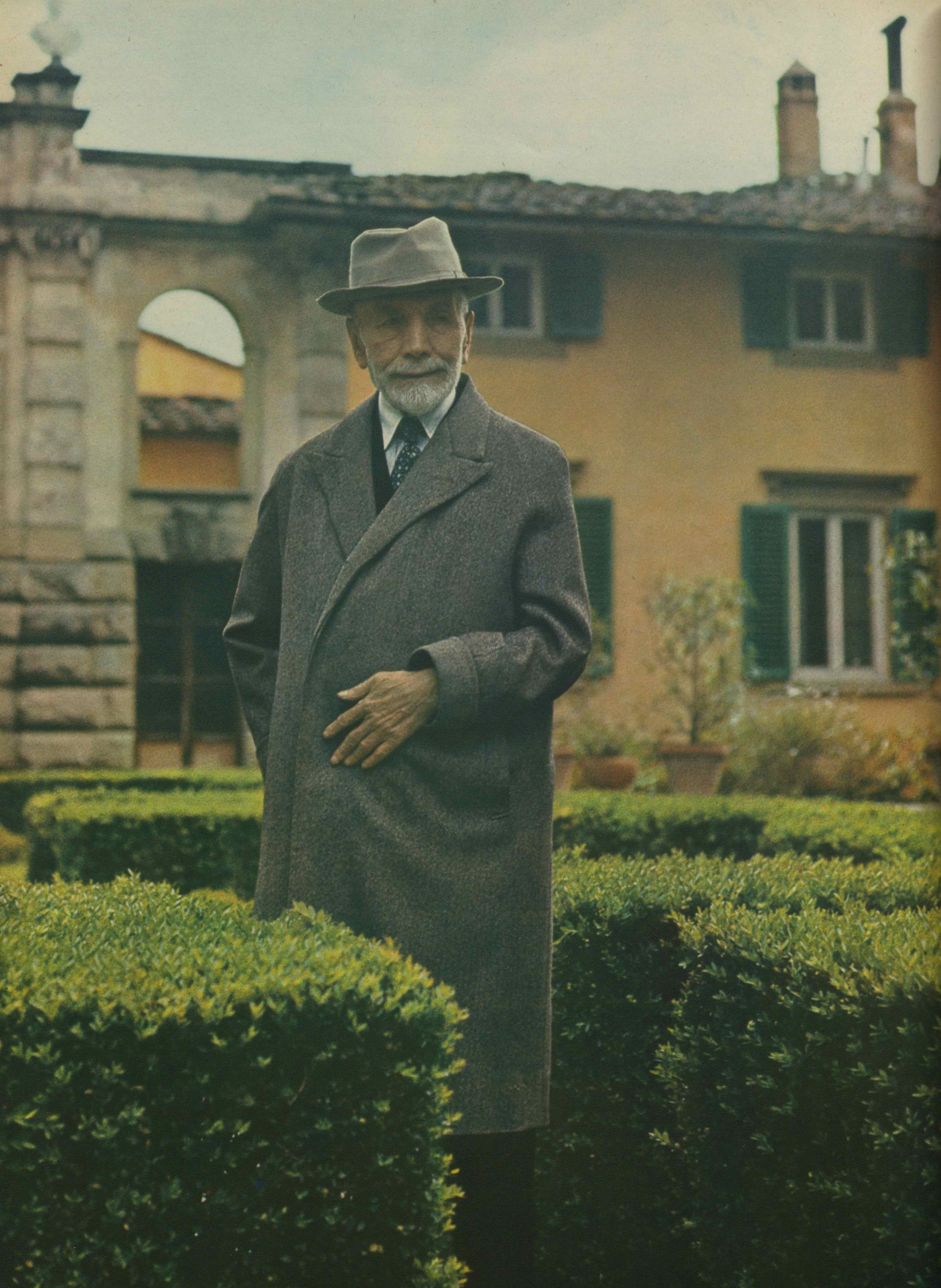

Four) Connoisseurship Is Not To Be Equalled With ›Judgment by Eye‹
The figure of the snobbish esthete that Daniel Day-Lewis has interpreted in the movie Room With a View has nothing to
do with the figure of Morelli. In fact: there could be no figure more different from Morelli than this one. But it seems
that, particularly in England, the very term of connoisseurship has this odour of class and snobbery, and I suspect that
this is the main reason behind the attempt to replace the term with that of ›judgment by eye‹.
Which, to me, seems to be another misunderstanding. Because, while there is something like a ›basta vedere tradition‹,
a probably rather anti-intellectual one, this tradition cannot be equalled with connoisseurship as such, which, it its
history, has been something broader, more complex, and also something, not always, but at times – more reflected.
And this is the reason why ›connoisseurship‹ cannot be named ›judgment by eye‹, since connoisseurship is encompassing
more, and also the reflection on how to look. On what, and to what purposes and to what results (yes, also the
results of looking have to be debated! and a language is necessary that is capable to transmit what someone has seen).
Whoever accepts this replacement runs into the danger of reproducting the Berensonian illusion, as one might call it, of
what connoisseurship is: a practice that is not and does not have to be reflected, does not have to be explained, and
does still acquire academic respect and, in its results rather than in its proponents: authority (and this for whatever
reasons, because scholarship would give up its fundaments, if it would accept that, or already has given up its
fundaments – by outsourcing of attributional problems to connoisseurs, whereever they may dwell, who do not have to
explain themselves, while still being regarded as being scientifically relevant. I have never understood why any serious
scholar could accept that. But the scholarly discipline of art history largely seems to have, and this is one of the
reasons why, polemically, but honestly, I have spoken of the lame-duckness of a whole scholarly discipline. Who seems to
have forgotten, in large parts, what the most basic scientific standards are and always have been.
In 1959, to come back to that era, an American scholar named Rodman Robinson Henry finished a PhD-dissertation on the
artist Boltraffio, and something untimely was part of it. Namely the attempt to develop a language that could, more or
less, adequately, describe the various individual styles of some of Leonardo da Vinci’s followers, not only of that of
Boltraffio, but actually of several of them. But this attempt remained an untimely one, remained without echo, which is
why, among other reasons, I am recalling it here: it is still untimely, in 2021, to think about an adequate language
for the description of individual styles, of form, of anything that might serve as a clue as to individual authorship.
But these attempts have to be remembered, because on such attempts the archeology of connoisseurship can built, as well
as the future of scientific connoisseurship, that would leave behind the Berensonian era and its aftermath, could.


Five) The Deplorable State of Morelli Scholarship in 2021
The state of Morelli scholarship in 2021 is largely deplorable. This does not mean that I am regretting to have put
online my Giovanni Morelli Monograph in 2015/16. Not at all. What I am deploring, however, is the egocentricity of
so-called leading scholars who chose to ignore it, ruling out, by that, to be able to learn something, potentially, from
what other people do. You can do that, but I would call that the worst kind of scholarship, completely dominated by
narrow-mindedness, self-interest and the will to monopolize certain scholarly fields. Even worse, I think, would only be
the using of other people’s work, while pretending that this work does not exist.
But it does. And the failure of a recent Digital Humanities project on Morelli shows that it could be useful and even
necessary to know about what I have done. If you try to model a digital tool that is supposed to emulate what Morelli did
or thought about (something that I wrote about five years ago, calling it ›Digital Lermolieff‹), it would be helpful to
avoid the general naiveté existing in the whole discipline of art history concerning Morelli and his methods and
practices. If you however try to built on the fragmentary knowledge existing, which is largely consisting of text book
clichés, half-truths and misunderstandings, you run into danger to fail, since you would not know about the ambiguities,
the practical problems that remained unnamed (also in Morelli’s own books) and the problem that Morelli did not at all
finish his project, and not even described it appropriatedly in his books.
The Digital Humanities project did fail, but seemed to have produced a learning effect, consisting in the insight that
not everything in Morelli is clear as to what Morelli had meant (which does also mean that so-called leading scholars
never had clarified it or even understood themselves), thus proving what I had written already five years earlier.
It could have been a useful starting point, if one had known about what I had written (attempting to name and to
discuss all the problems and ambiguities, and even developing the idea of thinking about to emulate it digitally, to be
able to learn about things, because this emulating does force you to clarify what Morelli had meant), and perhaps one had
known about it early enough, if other Morelli scholars had reacted, in one way or other, to what I had done. What happened,
brief, is telling, and I cannot help to say that scholarship could be more efficient than that. But this would imply that
there is scholarship, by which I mean: a social system called a ›scientific community‹, in which scholars respect
each other and think about what other scholars do or have created.
Selected Literature:
Rodman Robinson Henry, Giovanni Antonio Boltraffio. A Stylistic Study of his Works, PhD-dissertation, Boston 1959
Further Reading:
Dietrich Seybold, The Giovanni Morelli Monograph, Basel 2016

The Bottega of Leonardo da Vinci
The picture of the bottega of Leonardo da Vinci is not as blurred as one might imagine (for details see Seidlitz 1935, p. 530; Marani 1998). We will focus here on the early and middle years (up to 1512), and not on the late years, and one might begin with saying that with Boltraffio and Marco d’Oggiono we see two figures enter the orbit of Leonardo at the beginning of the 1490s that we believe to know rather well. We also see Salaì enter the orbit, at a very young age, and we have, in addition to that, a couple of names, names of figures that we do not seem to know very well, or not at all (a Giacomo, Giulio Tedesco, Galeazzo). Last but not least we have the Giampietrino problem: Giampietrino enters the scenery, but it is a matter of controversy (as far as this question is debated at all), when, since also Giampietrino is still very young.
It is noteworthy that Marco d’Oggiono, already at the end of the 1480s, seems to have had an own apprentice, and that Marco and Boltraffio did create the Pala Grifi together (a picture today in Berlin; picture above), even before Leonardo began to work at The Last Supper in 1495. Due to the work of Janice Shell and Grazioso Sironi we today do know more about Francesco Galli, also called Francesco Napoletano, who did die in Venice as early as 1501. One might imagine that Galli went to Venice with Leonardo in 1501, and if Galli, during the 1490s, for example might have cooperated with Marco, we would have found an interesting perspective: since, if only one single picture of the Marco group would be associated with Francesco Galli/Francesco Napoletano, we would have a picture with hand option 2, a picture that must have been created before Galli died in 1501. Which would mean that hand option 2 must have existed early, and my theory of the pentimento in version Cook as a mere switching from (preexisting) option 1 to (preexisting) option 2 would be positively proven as well as the theory of the pentimento supposedly showing the creative energy of genius (changing his mind) would be definitively falsified.
Brief: in the 1490s Leonardo mentions once that he had paid ›two masters‹ (probably Marco and Boltraffio) for two years; and once that he had six bocche to feed (probably again Marco, Boltraffio, plus Salaì and some of the unknowns).
Below a rather early Marco picture (according to Janice Shell), the Young Christ Blessing of the Galleria Borghese:
And here is a picture (not the only known picture) by Protasio Crivelli, formerly the apprentice of Marco d’Oggiono (picture by Sailko; the date appears to be 1498; location: Naples, Museo di Capodimonte):
In 1501 (3.4.) Pietro da Novellara informs Isabella d’Este that Leonardo seems to live ›from day to day‹ (see Marani 1998, p. 14). And he has seen Leonardo intervening from time to time in portraits done by two of his garzoni (»fano retrati«). But who are these, and which portraits are these (if this would have been about a Isabella d’Este portrait, Pietro would have noted; and after the Sforza had been expelled, portraits of court ladies and courtiers made no sense)? After having written on the picture of a young woman in the Columbia Museum of Art in one of the last episodes, I would now suggest the following:
Leonardo might have done a portrait of a Sforza court lady in the early Milanese years (and still in the Florentine portrait style), a portrait in terms of a drawing or a cartoon. He might have begun also a painting, but since the Sforza court got expelled and exiled after the French invasion, he might not have finished such portrait. He might instead have used it for the instruction of his garzoni: the Columbia picture might have been the one begun by Leonardo (as he seems to have begun portraits with the face, as later in the Mona Lisa), a picture that he might have had a pupil finish, with him retouching it again, adding some lustre. The picture in a private Russian collection might be a second version that he had a pupil repeat (after the first version and the drawing, respectively the cartoon). The Columbia picture shows much gusto for the grotesque, the second version less so, but still to some degree. Thus we would see pictures that have their origins in the first Milanese period (and even in the early Florentine period), but were actually done later (after 1500). And Leonardo might have had a hand in the Columbia picture whose head with the hair as well as the ornated hair net superbly being modelled into the dark is of exquisite quality (as also a single one pearl is, while other pearls are rather mediocre as also the bust and the modelling of the dress is). We see, as I have attempted to show in episode 13, two pictures that fit into the context of Leonardo’s thinking and doing rather than into the context of Boltraffio’s autonomous work: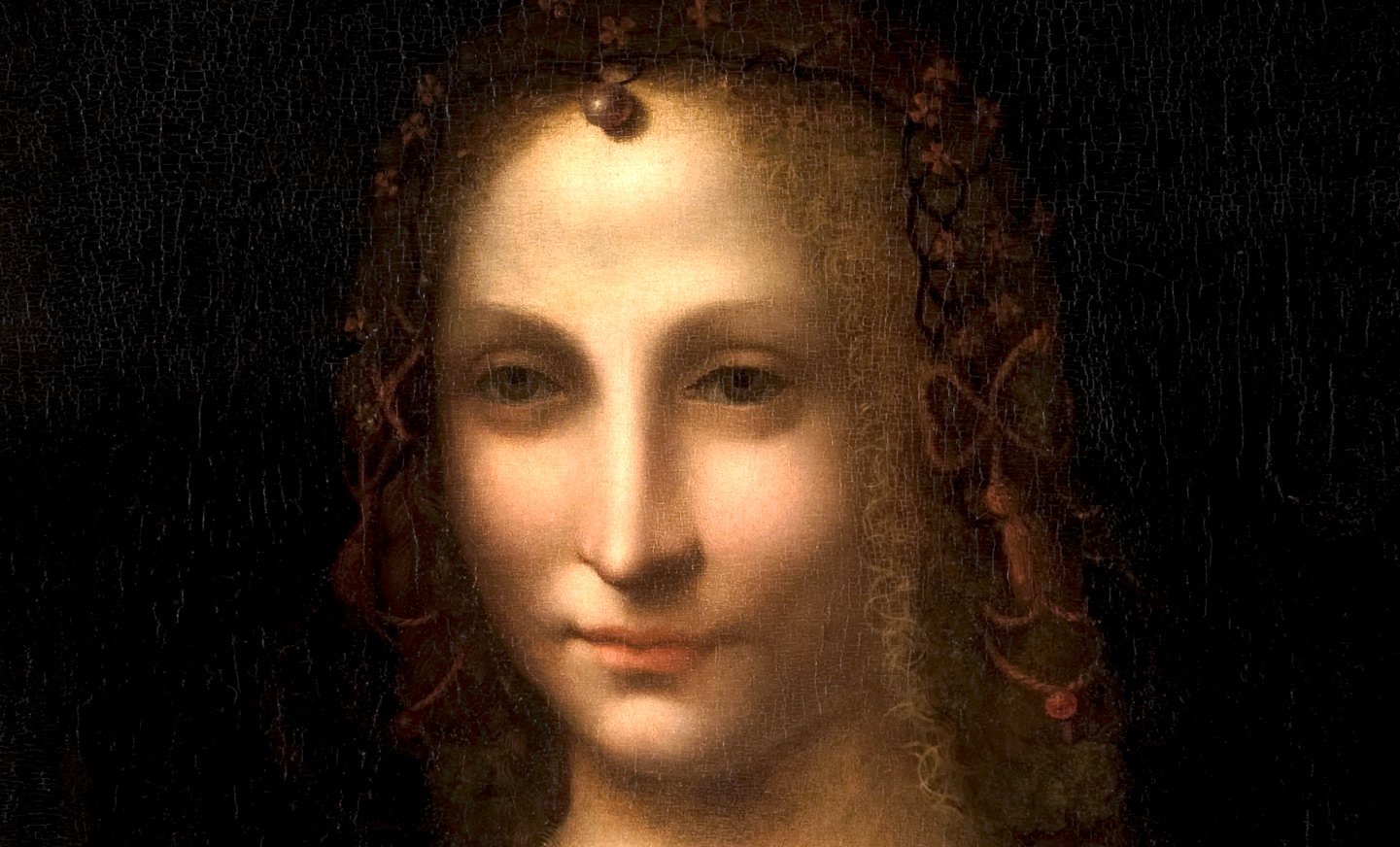
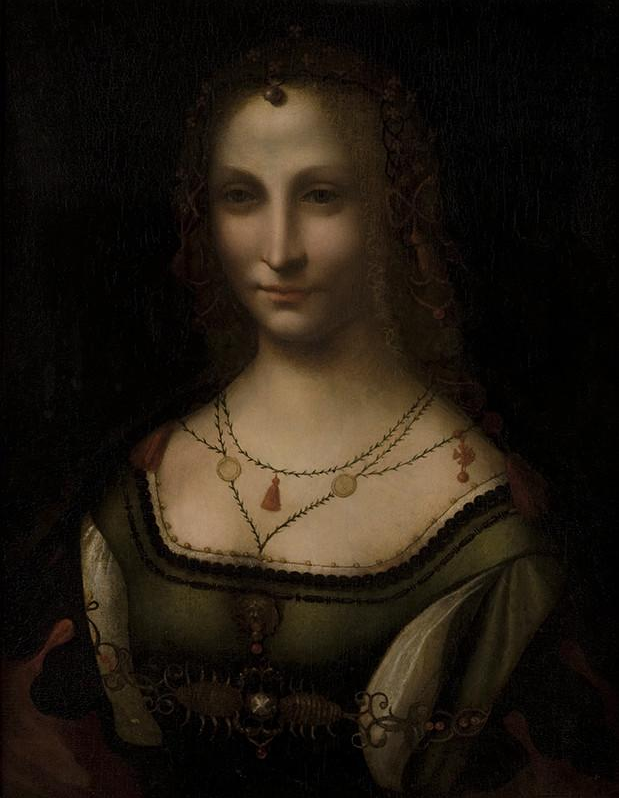
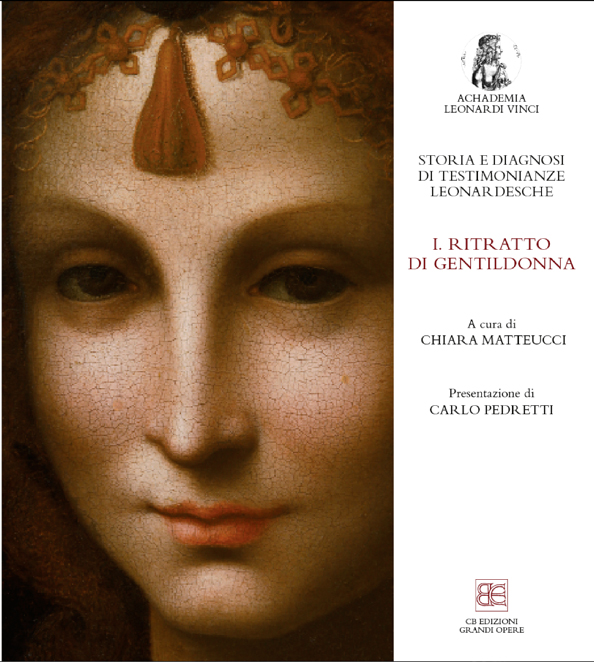
In 1504 a Jacopo Tedesco, in 1505 a Lorenzo (di Marcho) enter the orbit of Leonardo.
In around 1505 Fernando Yáñez enters the orbit of Leonardo, helping him with the Battle of Anghiari (as also does Riccio della Porta). Yáñez cannot be the author of the Prado Mona Lisa, if the Louvre Mona Lisa was finished only years later, since the dates (showing that Yáñez was active in Spain after 1506) do not allow to postulate it. In works of Yáñez done in Spain, however, we find echoes of Leonardo’s works (see the example below).
Around 1507 Francesco Melzi becomes a pupil of Leonardo (and also a sort of secretary).
In 1511 (or even earlier) Giampietrino is an autonomous master.
In 1511 Salaì seems to have created a (signed and dated) picture of Christ:
In around 1511 we see Marco, Boltraffio, Giampietrino and – Giovanni Agostino da Lodi in close contact, not only because we have a source indicating exactly that – we also have pictures indicating exactly that, and one of these pictures seems to be even dated (but the ›date‹ – ›XII‹ – is rather referring to the ›age of Christ‹):
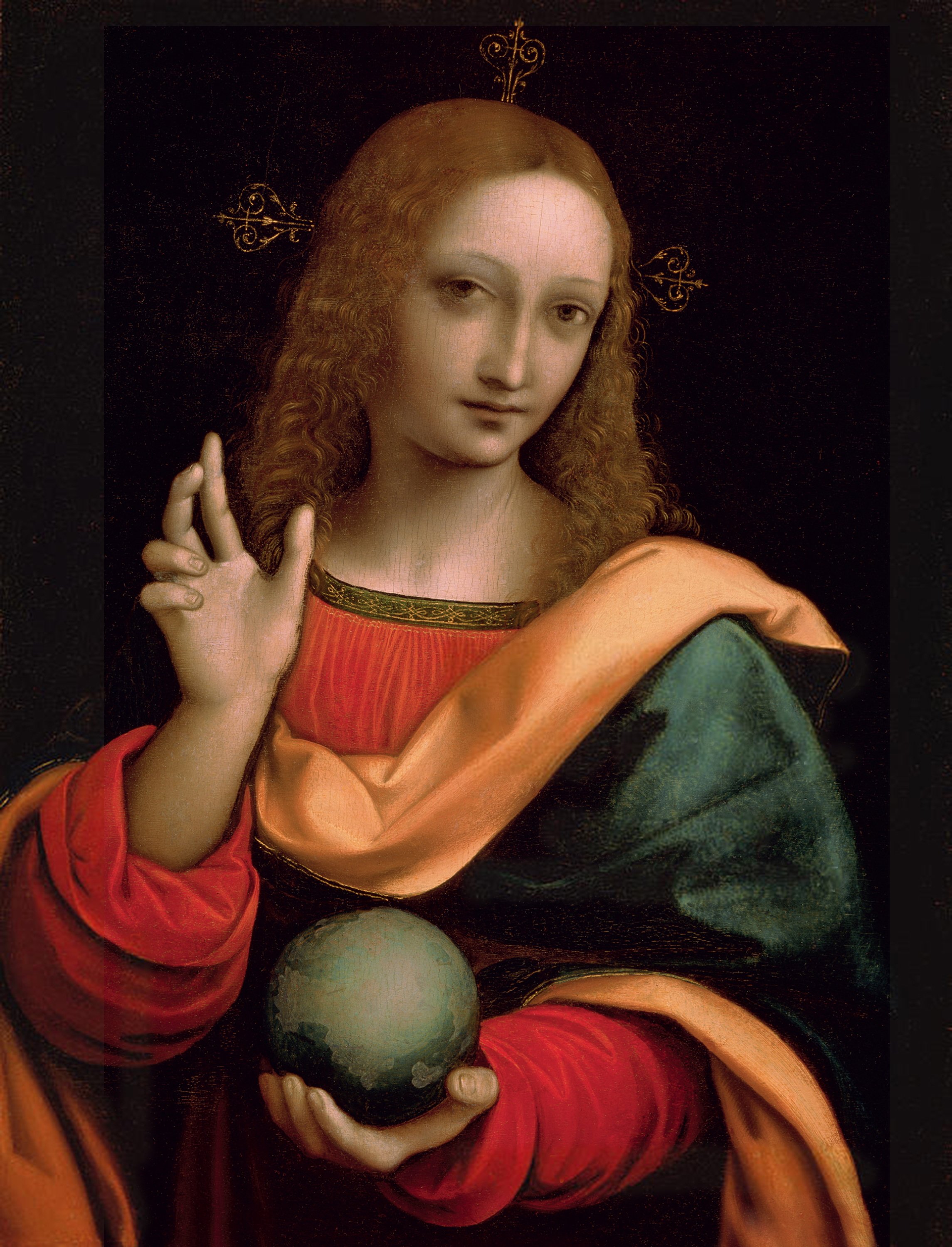
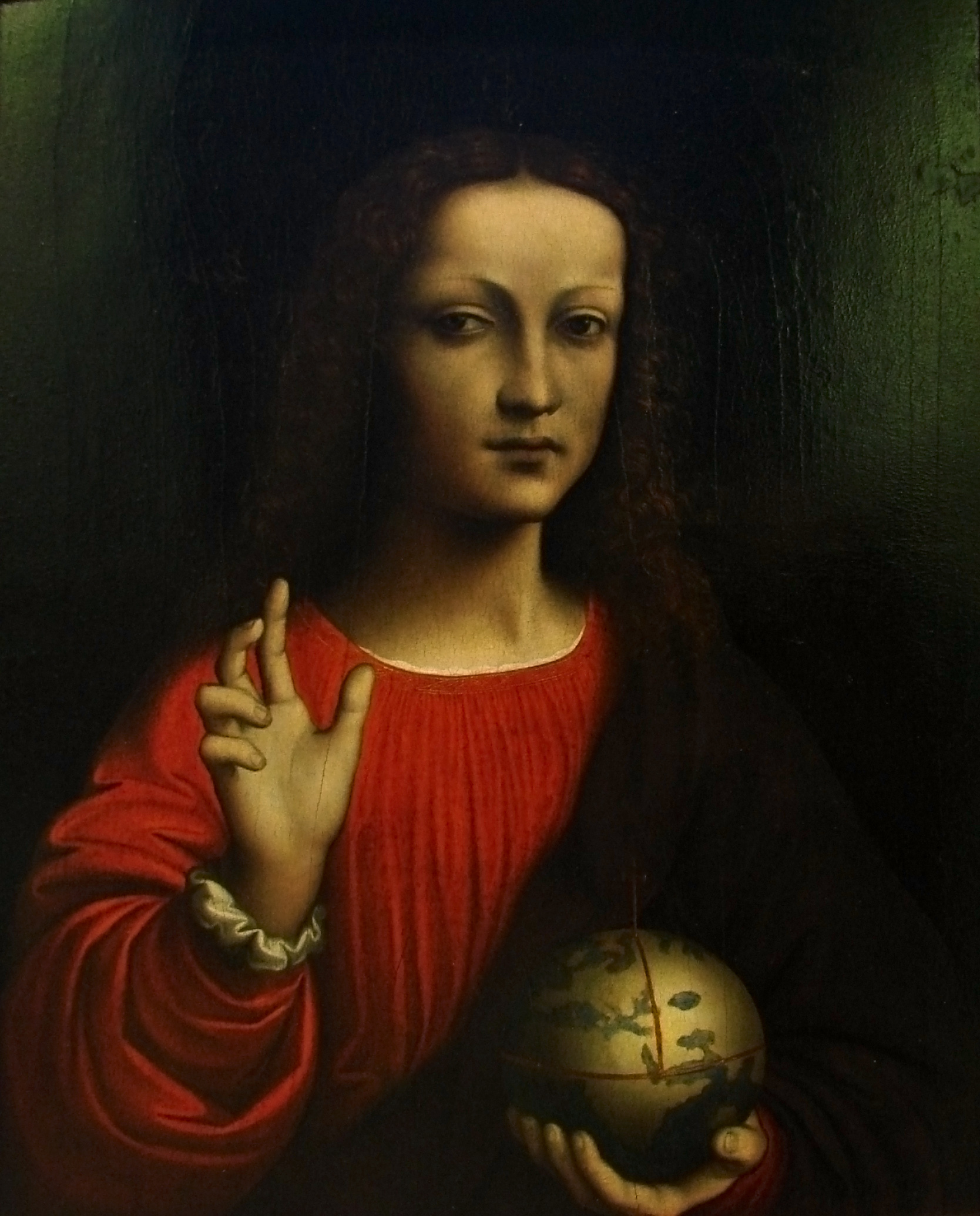
The Prado Mona Lisa (below) was probably begun at the time Leonardo also started reworking or completing the Louvre Mona Lisa, probably due to Giuliano de’ Medici wishing so, and hence perhaps in around 1511/12.
In around 1517 Marco d’Oggiono is cooperating with Giovanni Agostino da Lodi (see Shell, p. 173).
***
1516: Paolo Emilio, Italian-born humanist at the court of Francis I, publishes the first four books of his history of the Franks; death of Boltraffio.
1517: Leonardo da Vinci, with Boltraffio and Salaì, has come to France (picture of Clos Lucé: Manfred Heyde); 10.10.2017: Antonio de Beatis at Clos Lucé
1517ff: Age of the Reformation; apocalyptic moods; Marguerite of Navarre, sister of Francis I, will be sympathizing with the reform movement; her daughter Jeanne d’Albret, mother of future king Henry IV, is going to become a Calvinist leader.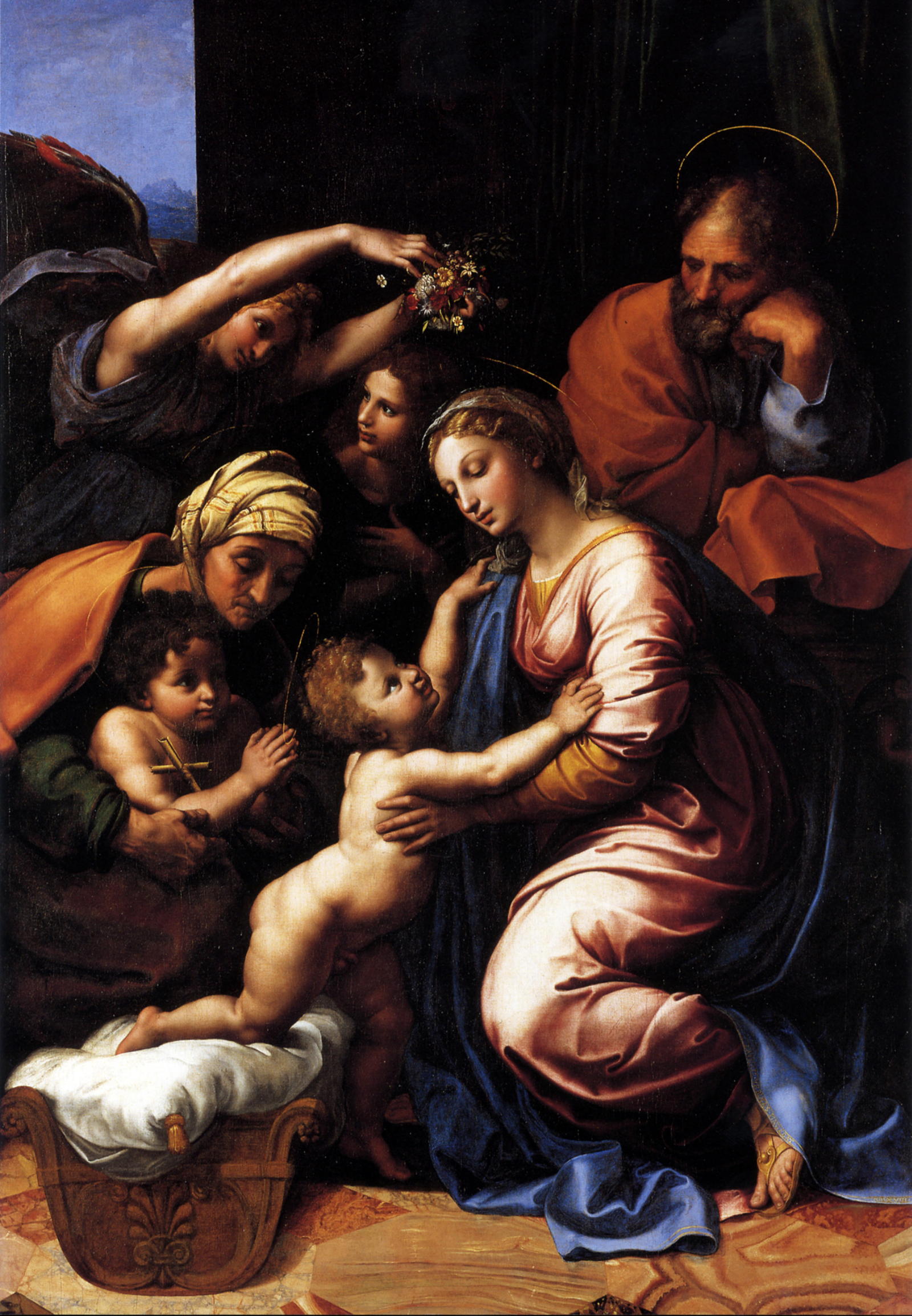
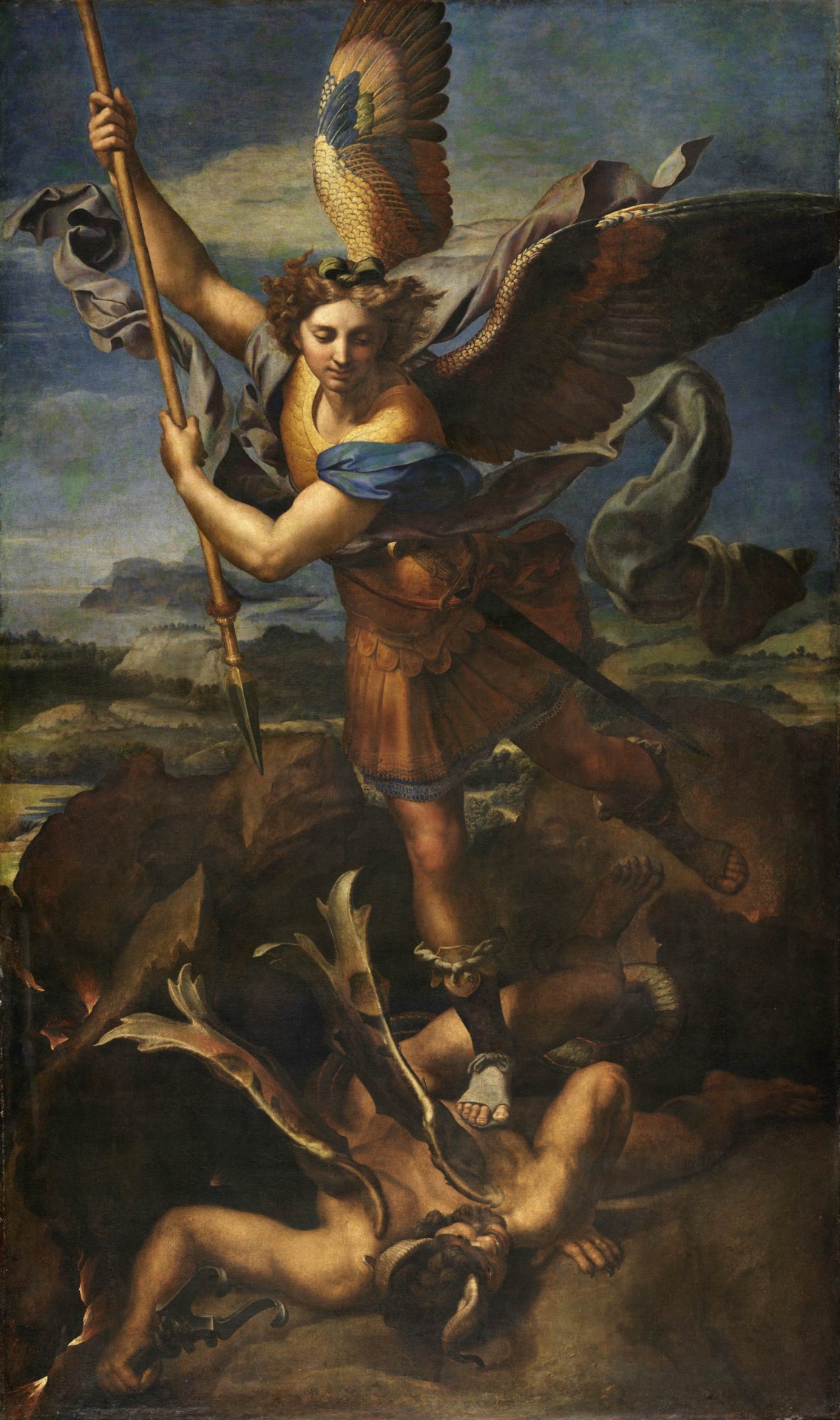
1518: the Raphael workshop produces/chooses paintings to be sent to France; 28.2.: the Dauphin is born; 13.6.: a Milanese document refers to Salaì and the French king Francis I, having been in touch as to a transaction involving very expensive paintings: one does assume that prior to this date Francis I had acquired originals by Leonardo da Vinci; 19.6.: to thank his royal hosts Leonardo organizes a festivity at Clos Lucé.
1519: death of emperor Maximilian I; Paolo Emilio publishes two further books of his history of the Franks; death of Leonardo da Vinci; Francis I is striving for the imperial crown, but in vain; Louise of Savoy comments upon the election of Charles, duke of Burgundy, who thus is becoming emperor Charles V (painting by Rubens).
1521: Francis I, who will be at war with Hapsburg 1526-29, 1536-38 and 1542-44, is virtually bancrupt.
1523: death of Cesare da Sesto.
1524: 19.1.: death of Salaì after a brawl with French soldiers at Milan.
1525: 23./24.2.: desaster of Francis I at Pavia. 21.4.1525: date of a post-mortem inventory of Salaì’s belongings.
1528: Marguerite of Navarre gives birth to Jeanne d’Albret (1528-1572) who, in 1553, will give birth to Henry, future French king Henry IV.
1530: Francis I marries a sister of emperor Charles V.
1531: death of Louise of Savoy; the plague at Fontainebleau.
1534: Affair of the Placards.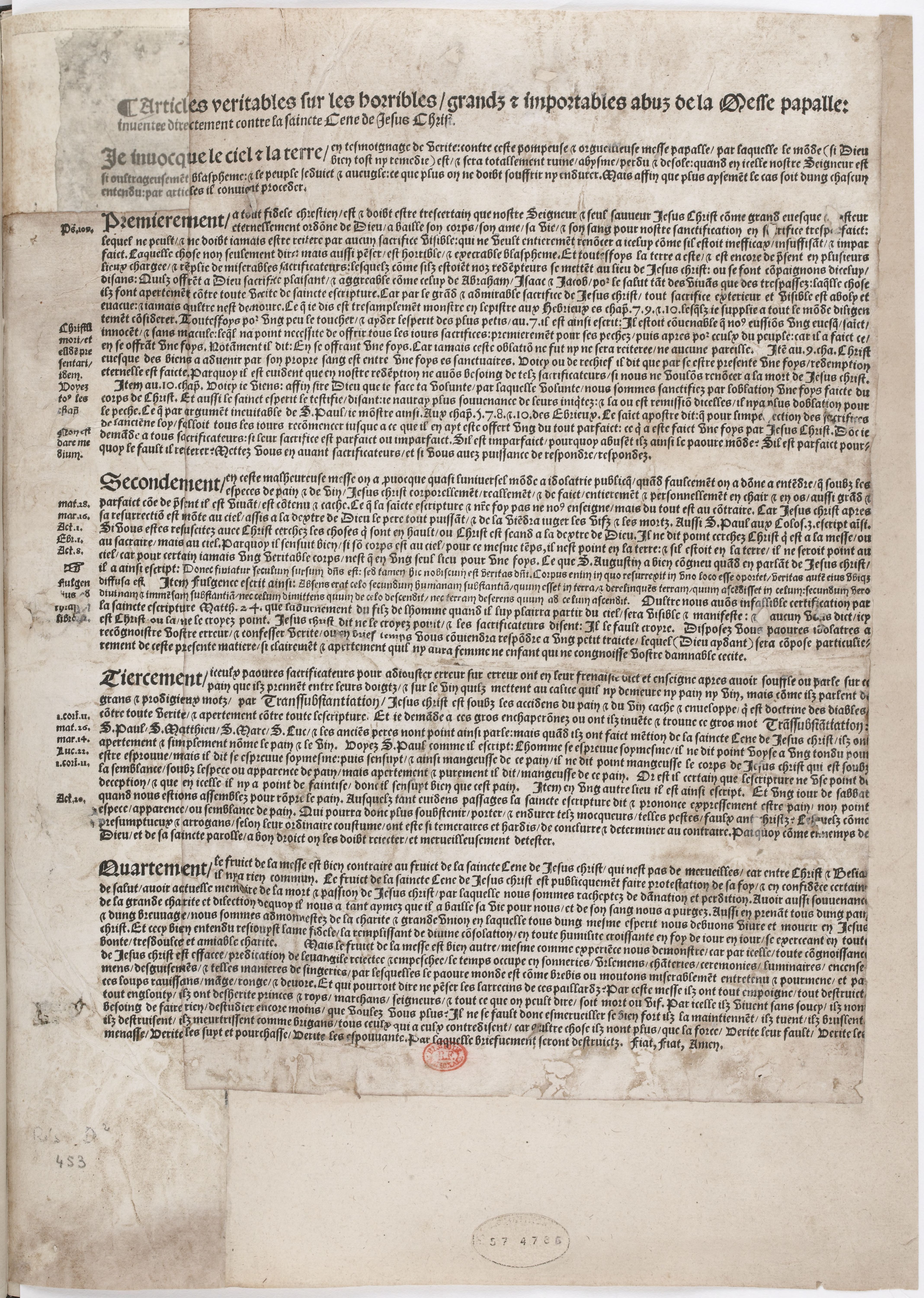
1539: the still unfinished chateau of Chambord is being shown by Francis I to Charles V.
1540s: the picture collection of Francis I being arranged at Fontainebleau.
1544: January: Marguerite of Navarre sends a letter of appreciation to her brother, king Francis I., who has sent her a crucifix, accompanied by a ballade, as a new year’s gift.
1547: death of Francis I.
1549: death of Marguerite de Navarre; death of Giampietrino.
1553: Jeanne d’Albret gives birth to Henry, the future French king Henry IV and first Bourbon king after the rule of the House of Valois.
1559: publication of the Heptaméron by Marguerite de Navarre.
1562-1598: French Wars of Religion.
1570: death of Francesco Melzi.
1589: Henry, grandson of Marguerite de Navarre and grand-grandson of Louise of Savoy, but by paternal descent a Bourbon, is becoming French king as Henry IV.
2015: an exhibition at the Château of Loches is dedicated to the 1539 meeting of king and emperor (see here).
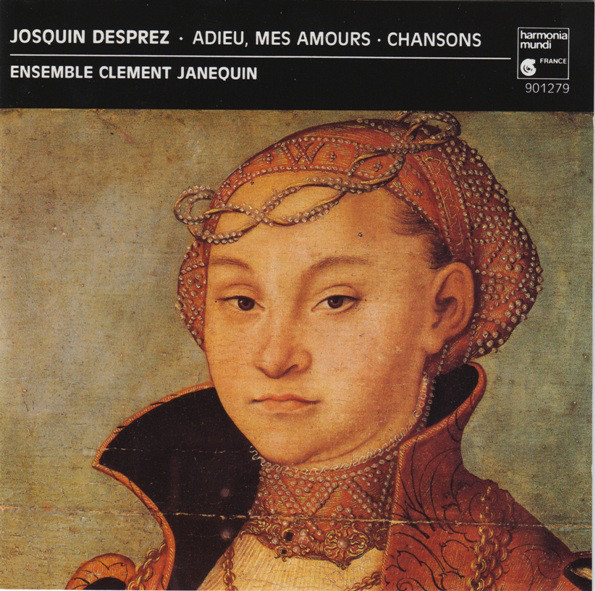
Perhaps a little surprising at first sight – to see a portrait by Lucas Cranach the Elder, chosen as the cover of a CD (picture above: discogs.com) with compositions of Josquin des Prez. But the music of Josquin – and the success of Josquin – was a European phenomenon. And as we have seen, Luther was a sort of opinion leader as far as the appreciation of Josquin was concerned. We see another, not a Milanese, but a Saxonian noblewoman. But we also have to acknowledge that Lucas Cranach was another painter who did – just like Leonardo – explore how the relation between viewer and a portrait could be organized: by a direct gaze, by a piercing, even inquisitory, unfathomable gaze, for example, which might be called one extreme of organizing this relation. And of challenging a viewer. Who looks back at a portrait that, as far as the gaze of the viewer is concerned, reacts like a mask. Which means: it seems that it does not react at all, because we don’t see any, or only little signs of outer or inner movement, raising the question, if, apart from the gaze, here we see a relation rather – or a duel: concerning the question ›who is the one who is more fathomable?‹. Is it the portrait or the viewer?
The work by Cranach does exist in two versions, and only one has a – more or less – direct gaze, that inspires us, again, to look at the Columbia portrait, the portrait of a Milanese noblewoman (and yes, I do think that Leonardo might have painted this face; we do know that Leonardo started a portrait with the face, and even if it was not Leonardo himself who did finish this picture (or was responsible for the rest of it), in my opinion there might be more Leonardo in this picture than – for example in the Musician. Our journey into musicology does already bear fruits in the field of art history. And I can only recommend further such excursions. Finally: the gaze of the Cranach portrait is definitely less piercing, and less direct than that of the Milanese noblewoman. The Saxonian noblewoman seems to be torn between looking at the viewer and distractely looking right through him, or even turning away from him, which might be interpreted as a sign of an inner movement. Of saying: ›I am sitting for you, but you are not important enough to distract me from my thoughts, my inner movements, my mourning or my joys. And these are none of your business, after all, even if I am sitting for you.‹ Our comparison results with saying: the Columbia portrait is decidedly the more extreme one, that seems to say: ›You know absolutely nothing about me – and you never will. Because it is my fate, my destiny, to reflect your gaze, as if my beautiful face was just a cold mask. And a sitter I am, too, but I am sitting here until the end of times.‹


See also the episodes 1 to 25 of our New Salvator Mundi History:
Francis I and the Crown of Charlemagne
The Chronicles of Santa Maria delle Grazie
A Brief History of Digital Restoring
Learning to See in Spanish Milan
And:
MICROSTORY OF ART
ONLINE JOURNAL FOR ART, CONNOISSEURSHIP AND CULTURAL JOURNALISM
HOME
© DS